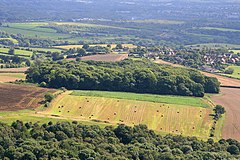Human settlement in England
| Little Wenlock | |
|---|---|
 The Old Quarry Plantation and Little Wenlock, seen from the Wrekin The Old Quarry Plantation and Little Wenlock, seen from the Wrekin | |
 | |
| OS grid reference | SJ645068 |
| Civil parish |
|
| Unitary authority | |
| Ceremonial county | |
| Region | |
| Country | England |
| Sovereign state | United Kingdom |
| Post town | TELFORD |
| Postcode district | TF6 |
| Dialling code | 01952 |
| Police | West Mercia |
| Fire | Shropshire |
| Ambulance | West Midlands |
| UK Parliament | |
| |
Little Wenlock is a village and civil parish in the Telford and Wrekin borough in Shropshire, England. The population of the civil parish at the 2011 census was 605. It was mentioned in the Domesday Book, when it belonged to Wenlock Priory. Ancient habitation is attested by the discovery of two caches of Bronze Age weapons. The village is situated two miles west of Dawley.
Nearby is the 1335-foot-high Wrekin, one of Shropshire's famous hills with an ancient hill fort. Part of it falls within Little Wenlock parish, while the adjoining parts fall into other parishes.
The name "Wenlock" as found in Much Wenlock and Little Wenlock (and also Great Wenlock, a now obsolete name, but found in some historic sources) is probably derived from the Old English *Wenan loca meaning "Wena's Stronghold" (wéna being feminine and meaning "hope") The town was recorded in the Domesday Book as Wenloch. The "Little" of the name distinguishes it from the larger settlement and market town of Much Wenlock, which is situated several miles to the south, on the other side of the River Severn.
11-year-old Alice Glaston from Little Wenlock was hanged together with two men in Much Wenlock on 13 April 1546, for an unknown crime. She is the youngest known girl legally executed in England.
The village features a public house (the "Huntsman Inn"), village hall, playing field and the Church of England parish church of St Lawrence. Charles Henry Hartshorne, antiquary and cleric, was curate at the church from 1828-1836, and David Cranage, later Dean of Norwich, was curate at the church in 1897-1898.
For many years there was small scale mining in the parish, for coal, limestone and fire clay.
See also
Notes
- "Civil Parish population 2011". Retrieved 28 November 2015.
- Local history from British History Online
- Worcester, Joseph Emerson (1823). A geographical dictionary or universal gazetteer, ancient and modern. Vol. 2 (2 ed.). Cummings & Hilliard. p. 876.
- ^ Surnames of the United Kingdom: A Concise Etymological Dictionary, Henry Harrison, Genealogical Publishing Com, 1996, 0806301716, 9780806301716. Page.270
- Butler, Sir Thomas (1861). The Cambrian Journal, 49. London. p. 89.
{{cite book}}: CS1 maint: location missing publisher (link) - "Alice Glaston". 19 March 2010.
- "Children & juvenile executions".
- WhatPub.com The Huntsman Inn, Little Wenlock
- Stephen, Leslie; Lee, Sidney, eds. (1891). "Hartshorne, Charles Henry" . Dictionary of National Biography. Vol. 25. London: Smith, Elder & Co.
- "Hartshorne, Charles Henry (HRTN821CH)". A Cambridge Alumni Database. University of Cambridge.
- "Cranage, David Herbert Somerset (CRNG885DH)". A Cambridge Alumni Database. University of Cambridge.
- "Little Wenlock: Economic history | British History Online". www.british-history.ac.uk. Retrieved 9 April 2018.